Table of contents
We built one of the most generous agency partner programs in SaaS, so why didn’t anyone know about it?
To really understand the answer to that is to understand the art of starting up. It’s manual. There are no processes to automate, lists to market to, or evangelists to…evangelize? So you start with one conversation. And then another. And when you’re lucky, lots more follow.
Before you can conceive of one to many, you need to master the art of one-to-one.
For the past year, that’s what folks here at Databox have been doing. Starting when Pete Caputa assumed the role of CEO in January of 2017, the process for attracting, closing, and onboarding agencies has been an obsessive approach to understanding the challenges they’re facing, and developing and iterating on solutions to address them.
That’s a conversation. Not a dictation.
Luckily, we had Pete’s experience in building and scaling HubSpot’s Partner Program (nine years in the making) in our back pocket. That acted as our scaffolding.
After several months of Pete and the product team’s efforts, Pete began building a team across sales, marketing, and customer success to help agencies not only with adoption of the product, but also teaching a new approach to setting goals, tracking progress, and improving performance.
From there, the team talked with even more agencies. Lots of them. Their challenges become our challenges, and perhaps more precisely, our product roadmap. We’d work to reach consensus on the specific problems we wanted to tackle. Were they real or nice-to-haves? The universal challenges we uncovered became our direction.
It was working.
We saw, and continue to see, month over month growth. Hundreds of new agencies were signing up every single month (and still growing.) But for the next phase of growth, Pete knew they’d need to increase awareness, move product education further up the funnel, and further enable our self-serve model in order to scale an already sound process.
That’s when I joined the team, not just as the resident historian and storyteller 😉 , but to help with product marketing and conversion optimization across the entire funnel from first touch to the most recent one each partner has with us.
Here’s how we went about it…
We increased our content output
In early 2017, led by Kevin Kononenko, we jump-started our content marketing efforts in earnest. (You might have noticed we’ve been publishing 3+ articles a week for a year now.) Through original 1:1 research, surveys we run, and guest posters we’ve recruited through blogger outreach, we have been putting out lots of content about marketing and sales, some of which was positioned toward agencies.
It resonated. Then it compounded. As of November 1st, website traffic has increased by 378% YoY.
We launched a partner directory
Blogging led to more signups, too, not just traffic. And with the help of our first sales hire, Brian Moseley, we signed up 52 partners by May 2017.
Tory Sher, our Partner Onboarding Manager, provided first-level, 1:1 support to help them learn the software, create standardized reports, and roll out automated reporting to their clients.
But, as with any software, some partners master it faster and better than others.
Anticipating this, the team launched a directory to show off which partners know the platform the best. After adding 150+ partners to the program, we now present the best partners at the top. (Pictured below.)
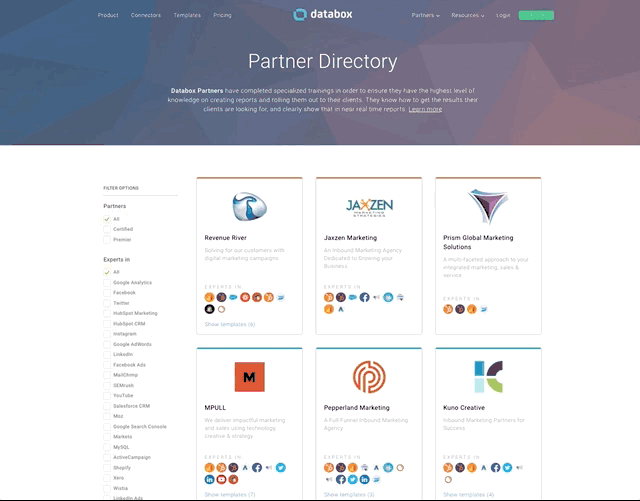
With our directory, not only are we helping our customers find our best partners, we’re also rewarding the partners who put in the effort to help us improve.
Further, having a partner directory sends a signal to potential partners that we’re serious about helping them grow.
We started connecting our users with our partners in the product
In addition to the partner directory, we launched a KPI Template Report Gallery, which features a library of reporting templates built right into the Databox product, each authored by our community of partners.
Every time a user signs up for our product, they’re prompted to download a template. And every time a partner’s template is downloaded, the agency gets notified and can follow-up to offer support. It’s no added work for them, as they’re creating these reports anyways for their own clients, but it opens up a new channel for lead generation that only gets more effective as we grow.
In the last 30 days, 3,780 templates have been used by our users.
We started marketing with our partners
A few weeks ago Pete parroted a message to me that he’d once heard from Dan Tyre in the early days of HubSpot: “make your best partners famous.”
That mentality has been baked into the marketing, sales, and customer success process here at Databox since day one.
In addition to the partner and template directories mentioned above, we build partner co-marketing into every one of our marketing activities.
Case Studies
As partners like IMPACT and Revenue River adopted our product across their entire client base, we asked them if we could tell their story.
IMPACT even guest-hosted a webinar with us to share their process for rollout. You can read all about it here.
Others shared how it was changing not only their internal processes, but the client/agency relationship in general.
“The way we report has changed since setting up dashboards. The meeting can be focused on actual data and discussing it, rather than simply reporting results. We can build multiple dashboards to speak directly to different people in the room, from executives to specialists.”
 Linda Kyzar
Linda Kyzar
Sr. Marketing Manager, Stream Creative
Content like this helps us communicate the value of our product, but also helps them communicate how awesome they are to their potential clients.
Research
Our marketing features a ton of original research collected via surveys, like this one, wherein we survey our entire agency ecosystem on a variety of topics related to business, marketing, and technology, and publish the research on our blog, giving them credit for their submissions, of course.
Product Launches
We’re also giving the floor to agency partners during product launches, as we did most recently with the launch of our Client Performance feature. By incorporating PR 2020’s Keith Moehring’s point-of-view right into the launch, the positioning felt much more authentic. We felt Keith’s story of how this feature was working was much more interesting than any conversion copy we could write, so we let him have the floor (so to speak.)
Our Podcast
We launched a podcast in October, and among the planned guests of the show are some of our agency partners with unique and fun stories to tell. Like this episode with Paul Roetzer, founder of PR 20/20, our plan is to highlight unique and interesting stories on agency growth.
We launched a page just for agencies
As you solve old problems, new ones arise. Ours was this; we had all of these agencies reading our blog and wondering how to get listed in our directories, yet there was little to no education around how the product helped their specific use case or the benefits of the partner program in general.
This became the logical starting point for moving product education further up the funnel. What I mean by that is, up to that point, education around the agency use case was learned throughout the sales process and onboarding, in other words, for users and customers.
But what about everyone else? Website visitors? Those still in the evaluation phase?
To scale quickly and efficiently, we’d need to bring that education further up the funnel to cover them, too.
First, we needed a page that clearly communicated the benefit that Databox offers to agencies. What were we helping them solve? How was it different from what they were doing now?
We leaned into what we already knew about our current agency customers–why they bought, how they were implementing Databox, how the product was changing their business, etc., and talked with many of them one-to-one in order to validate the positioning we had come up with.
Here’s where we ended up…
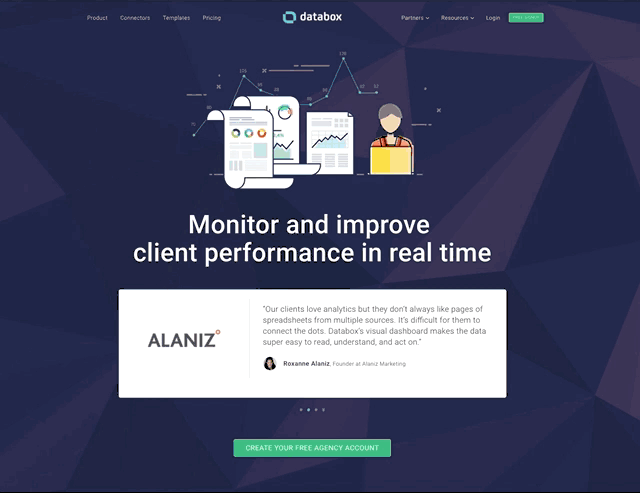
We also launched a page specifically for HubSpot Partners
Because of our deep integration with HubSpot–and also because of the relationships Pete had built in roughly a decade of working with agencies–we’ve also established a really strong foothold within the HubSpot Partner community.
We knew there was a strong opportunity to appeal to even more HubSpot partner agencies by specifically highlighting our integration as well as our experience in working with many others like them. So, we created a page specifically for HubSpot partner agencies.
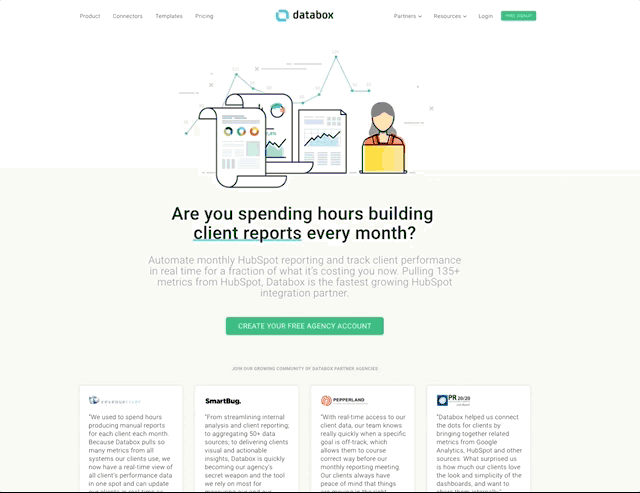
You’ll notice that, while similar to the agency page, there are differences in verbiage, specifically as it relates to the benefits.
We answered the question, “Where can I see agency pricing?”
This was one of the most frequent questions we’d hear from prospects and even Agency Free users.
And while Agency Free users could view pricing inside of their account, once again, we wanted to bring this level of awareness further up the funnel. So we published our agency packages on the website and allowed users to toggle between standard and agency pricing options.
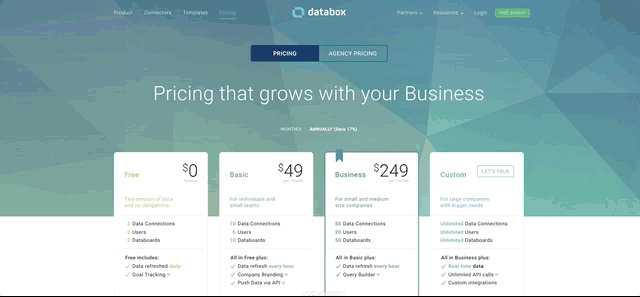
By implementing these agency-specific pages on the website, it also allowed us to engage in more targeted conversations using Drift.
Drift’s value proposition is no secret, so I’ll spare the product placement, but in the early going, Drift has allowed us to have conversations with people that have questions on these pages, but otherwise may not have reached out.
We added links to our agency pages in our navigation
After creating these new and valuable resources for agencies, we knew we needed to surface them prominently in order to increase traffic flow.
The biggest and most obvious opportunity was reworking the main website navigation. This required only a small change, as after monitoring engagement data in Lucky Orange, we saw that “Blog” saw the least amount of engagement by far. This would make sense, as most people finding our blog posts do so through organic search, social media, or referrals.
We rolled “Blog” in with “Resources” in the main navigation, and introduced a “Partners” dropdown that featured “Find a Partner” and “Become a Partner.”
This became the gateway into learning more about our agency products and partner program. And it’s worked.
Among all of the elements on our homepage, “Partners” in the navigation is the 11th most clicked element on the page, driving hundreds of clicks a month to our agency pages.

Keep in mind that previously, there was nothing linking homepage visitors to our partner pages unless they scrolled all the way to the footer (only 19% of visitors actually did, via Lucky Orange.)
Of that small segment, only five (five!) people actually clicked the partner directory in the footer over the last month.
Not only have we expanded our offering of agency resources beyond the partner directory, we’ve also significantly increased traffic flow to enable relevant users to learn more, sign up, or get in touch with sales.
We implemented lead nurturing to better educate new agency users
Early on, I wanted to understand some of the common questions and challenges agencies were having in getting set up. I talked with both Tory Sher and Brian Moseley, our Partner Onboarding and Development Managers, respectively, a lot early on to get a feel for the common questions and challenges people were having when starting up.
From there, the goal was to reduce the volume of questions, and therefore manual tasks Tory and Brian were doing to address them, through a more comprehensive onboarding sequence.
We weren’t looking to replace the one-to-one nature of Tory or Brian’s calls, but if we could educate agency users at an earlier point in the customer lifecycle, it would only improve their experience and deliver value quicker.
This would also, in theory, help Tory to have deeper conversations in later calls, as users would have had a chance to discover and use key features already.
We developed what we called “The Agency Six”–six emails focused on some of the most common questions agencies were having in getting started. By sending these six emails within the first six days of signing up, we could help get agencies up the learning curve much quicker.
- Day 1: Welcome!
- Day 2: Client Performance
- Day 3: Goals
- Day 4: Annotations
- Day 5: Mobile
- Day 6: The Partner Program
You’ll notice that in some of these emails there are links to a recording like this one. While many companies default to listicles and checklists for product onboarding, we wanted to inject personality into the process to avoid sounding cold and robotic. (It’s easy to come across that way when you’re talking about performance tracking, KPIs, etc.)
Plus Wistia’s Soapbox tool is just really freakin’ cool and easy to use.
While it’s still early days, the response to “The Agency Six” has been immediate.
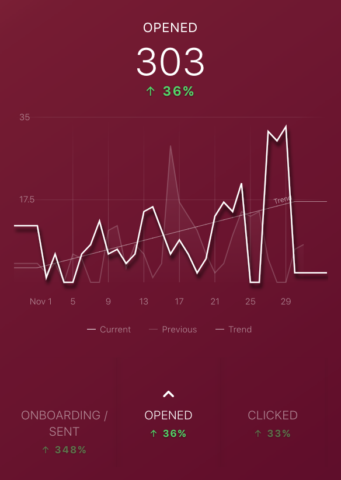
While I certainly don’t want to devalue “clicks”, the fact that email opens are up by over 35% is massive when you’re trying to increase top-of-mind awareness and improve education.
Sometimes people are in the middle of something when they receive your email, but saw a notification and checked anyways. Or they’re in line getting coffee, or lunch, and checking their phone to kill time.
The most important thing for us is raising awareness at an earlier point, therefore opens, and not necessarily clicks, is a perfectly fine indicator that our Agency Free users are learning about key features at a much earlier point.
We solicit and listen to feedback
If it’s not obvious after reading this article, we consider our partners an extension of our team. We think of them more like employees rather than customers.
To make any intimate working relationship work, listening and adapting to feedback is critical.
We’ve come a long way in a short period of time because we’ve been able to automate much of our marketing and communication. But we haven’t abandoned the one-to-one approach that’s gotten us this far.
In fact, many of the measures we’ve implemented require it. Template Gallery, research and surveys, product launches, podcast recordings–these require a deep and continuous relationship with our growing partner community.
The best part of all that interaction is that we get to learn from our partners and improve as we grow.
If you’re interested in joining us on this journey, apply here. To get started without talking to us first, sign up for our Agency Free plan. You’ll receive “The Agency Six” within the first week. 🙂



















